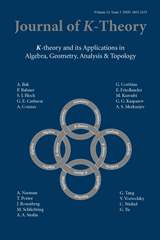Article contents
Grothendieck groups for categories of complexes
Published online by Cambridge University Press: 09 January 2008
Abstract
The new intersection theorem states that, over a Noetherian local ring R, for any non-exact complex concentrated in degrees n,…,0 in the category P(length) of bounded complexes of finitely generated projective modules with finite-length homology, we must have n ≥ d = dim R.
One of the results in this paper is that the Grothendieck group of P(length) in fact is generated by complexes concentrated in the minimal number of degrees: if Pd(length) denotes the full subcategory of P(length) consisting of complexes concentrated in degrees d,…0, the inclusion Pd(length) → P(length) induces an isomorphism of Grothendieck groups. When R is Cohen–Macaulay, the Grothendieck groups of Pd(length) and P(length) are naturally isomorphic to the Grothendieck group of the category M(length) of finitely generated modules of finite length and finite projective dimension. This and a family of similar results are established in this paper.
Keywords
- Type
- Research Article
- Information
- Copyright
- Copyright © ISOPP 2009
References
- 6
- Cited by


